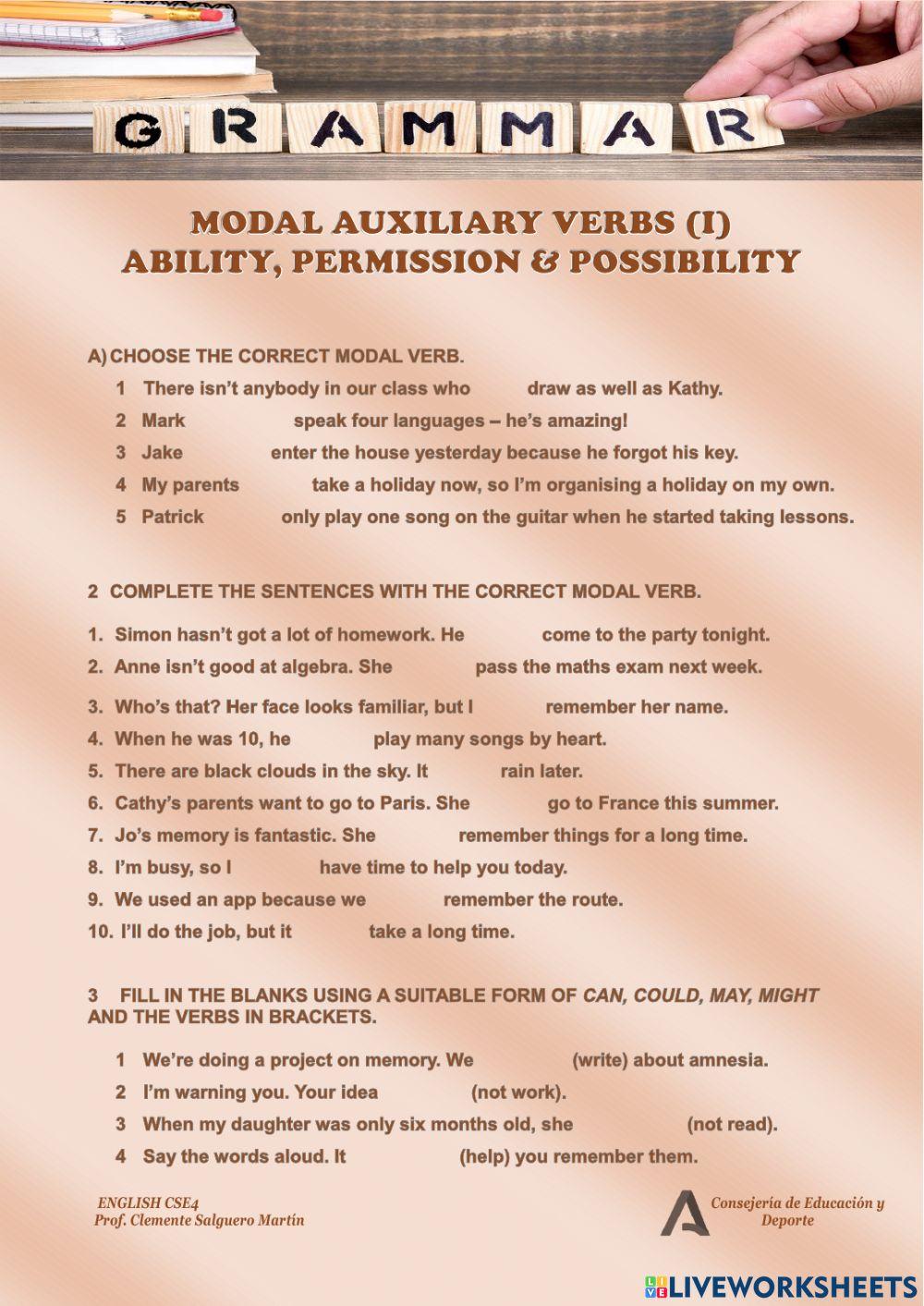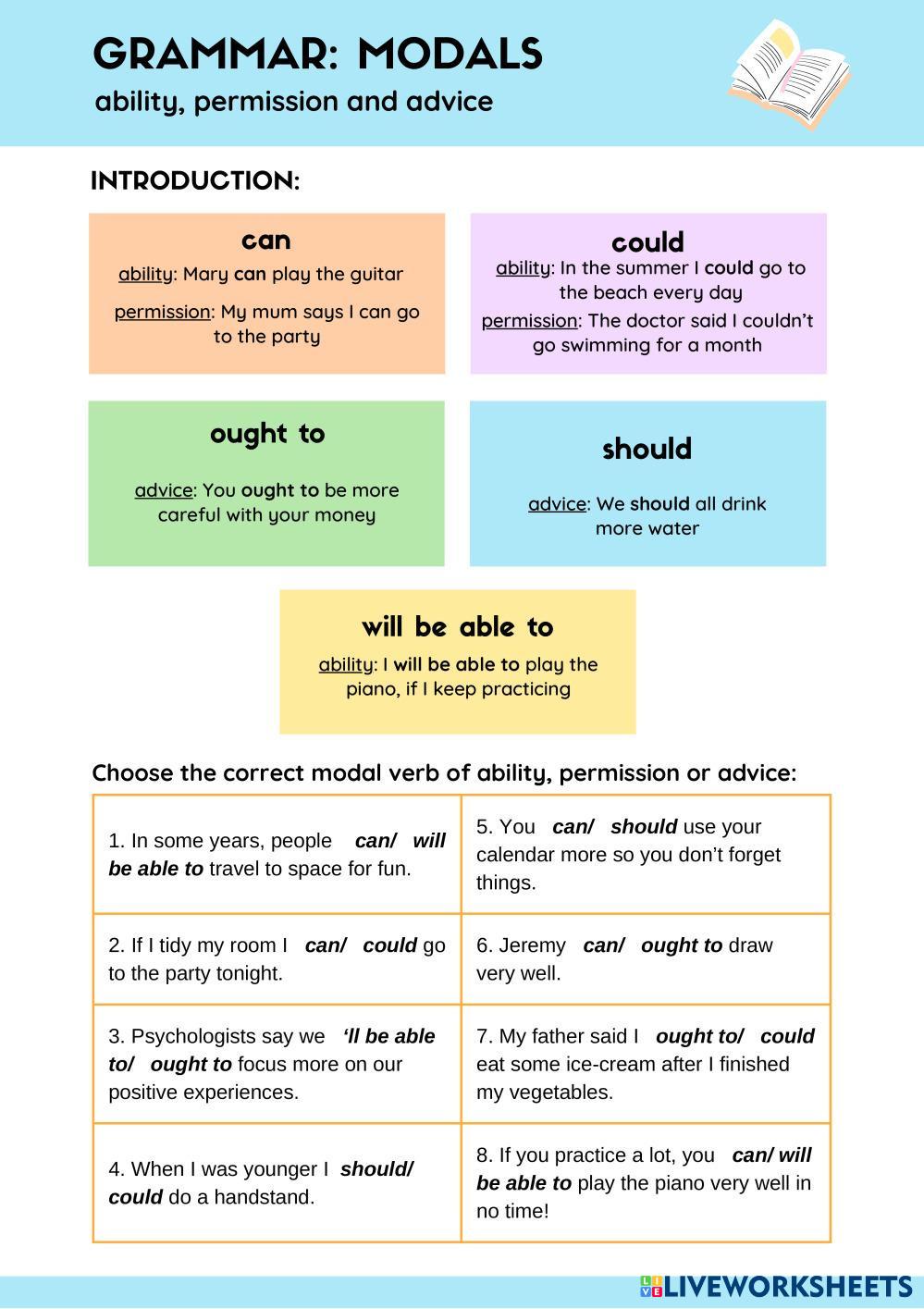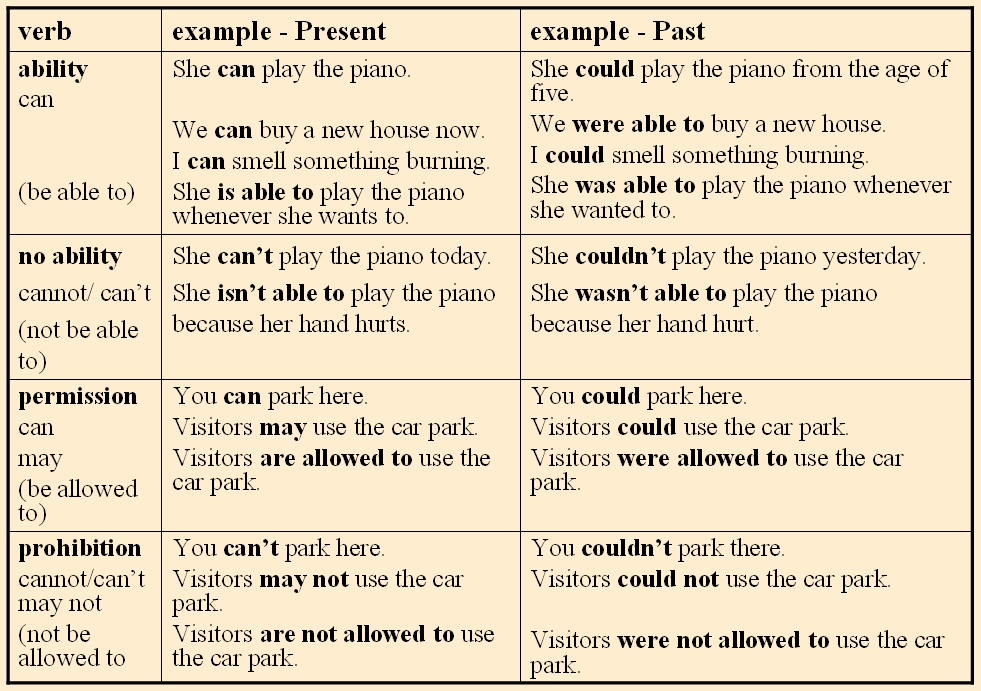
Mastering the Modals: The Indispensable Role of Permission vs. Ability Worksheets
The English language, with its rich tapestry of nuances, often presents learners with subtle yet significant distinctions that can profoundly impact communication. Among these, the difference between expressing permission and expressing ability stands out as a common stumbling block for both native and non-native speakers alike. While seemingly simple, the appropriate use of modal verbs like "can," "could," and "may" to convey these concepts is crucial for politeness, clarity, and grammatical accuracy. This is where well-designed permission vs ability worksheets become an invaluable pedagogical tool, offering structured practice that solidifies understanding and fosters confident usage.
The Linguistic Landscape: Permission vs. Ability
At its core, "ability" refers to the capacity or power to do something. We use "can" (present ability), "could" (past ability or hypothetical ability), and "be able to" (more formal or for future ability) to express this. For example:

- "I can speak three languages." (Present ability)
- "She could run a marathon when she was younger." (Past ability)
- "He will be able to join us after his meeting." (Future ability)




"Permission," on the other hand, refers to being allowed or authorized to do something. The primary modal verbs for permission are "can" (informal), "could" (more polite), and "may" (formal and polite). Consider these examples:
- "Can I borrow your pen?" (Informal request for permission)
- "Could I open the window?" (Polite request for permission)
- "May I have a moment of your time?" (Formal request for permission)


The overlap of "can" for both ability and informal permission is precisely what causes confusion. A phrase like "Can I go?" could mean "Am I capable of going?" or "Am I allowed to go?" The context usually clarifies, but for learners, this ambiguity can be a source of anxiety and errors. Furthermore, the politeness continuum (can < could < may) is vital for social appropriateness. Misusing these verbs can lead to perceived impoliteness or a lack of sophistication in communication.
Why Permission vs. Ability Worksheets Are Essential

Given the intricacies, rote memorization alone is often insufficient. Learners need repeated exposure and active engagement with the concepts in varied contexts. This is where permission vs ability worksheets prove their worth. They provide a controlled environment for learners to:
- Differentiate Clearly: By presenting sentences side-by-side or in contrasting scenarios, worksheets force learners to consciously choose between permission and ability.
- Practice Contextual Usage: Effective worksheets don’t just ask for isolated words; they embed the modals in realistic dialogues, short paragraphs, or situational prompts, encouraging learners to consider the social and communicative context.
- Reinforce Politeness Levels: Many worksheets include exercises that specifically target the formal vs. informal distinctions, guiding learners to select "may" for more formal settings or "could" for polite requests.
- Identify Common Errors: Worksheets can be designed to highlight typical mistakes, such as using "can" when "may" is more appropriate for a formal request, or confusing "can" with "know how to."
- Build Confidence: Consistent, successful practice on worksheets builds a learner’s confidence in applying these grammatical rules in spontaneous conversation and writing.

Types of Effective Permission vs. Ability Worksheets
To cater to diverse learning styles and address different aspects of the distinction, a variety of worksheet formats can be employed:
-
Fill-in-the-Blanks: These are foundational. Sentences with a blank space require the learner to insert the correct modal verb (can, could, may) based on whether permission or ability is implied.
- Example: "My little brother __ tie his shoelaces yet." (Ability)
- Example: "Excuse me, __ I ask a question?" (Permission)
-
Multiple Choice: Learners choose the best modal verb from a given set of options, often with distractors that test their understanding of nuance.
- Example: "__ I use your phone for a moment?" (a) Can (b) May (c) Will (d) Must
- Example: "After months of practice, she __ finally play the piano beautifully." (a) May (b) Is able to (c) Should (d) Might
-
Sentence Transformation: These exercises challenge learners to rewrite sentences, changing an expression of ability into a request for permission, or vice versa, often varying the level of politeness.
- Example: "I can lift this heavy box." (Ability) -> "Could you help me lift this heavy box?" (Request for help, implying permission/assistance)
- Example: "You are allowed to leave now." (Permission) -> "You can leave now." (Ability/Permission)
-
Dialogue Completion: Worksheets provide incomplete dialogues where learners must choose the appropriate modal to make the conversation sound natural and grammatically correct, focusing on the back-and-forth of requests and granting/denying permission.
- Example:
- A: "Excuse me, __ I sit here?"
- B: "Yes, you __."
- Example:
-
Error Correction: Learners are given sentences with incorrect modal usage and must identify and correct the error, explaining why their correction is better. This promotes critical thinking about grammar.
- Example: "I may speak French fluently." (Correction: "I can speak French fluently.")
- Example: "Can I enter the principal’s office?" (Correction: "May I enter the principal’s office?" – more polite/formal)
-
Situational Prompts/Role-Playing Scenarios: While not strictly a "worksheet" in the traditional sense, prompts on a worksheet can set up scenarios for oral practice. Learners are given a situation (e.g., "You want to ask your teacher to extend a deadline," or "You are describing your talents for a job interview") and must write sentences or dialogues using the correct modals. This bridges the gap between written practice and spoken application.
-
Categorization/Sorting Activities: Learners sort a list of sentences into "Permission" or "Ability" categories, or even further into "Informal Permission," "Polite Permission," "Present Ability," "Past Ability," etc.
Designing Effective Permission vs. Ability Worksheets
To maximize the impact of permission vs ability worksheets, educators and materials designers should consider several key principles:
- Clear Instructions: Ensure learners understand exactly what is expected of them. Ambiguous instructions can hinder learning.
- Contextual Relevance: Sentences and scenarios should be relatable and meaningful to the learners’ lives. Abstract grammar exercises are less engaging and less effective.
- Gradual Difficulty: Start with simpler distinctions and gradually introduce more complex scenarios, including the politeness continuum and the use of "be able to."
- Variety of Exercise Types: Don’t rely on just one format. A mix of fill-in-the-blanks, multiple choice, transformations, and dialogue completion keeps learners engaged and addresses different aspects of the skill.
- Authentic Language: Use natural-sounding English rather than overly simplistic or artificial sentences.
- Inclusion of Distractors: For multiple-choice questions, include options that are grammatically incorrect or semantically inappropriate to truly test understanding.
- Answer Keys: For self-study or peer-correction, a clear answer key is essential for immediate feedback.
- Visual Appeal: Well-designed worksheets with clear layouts, appropriate spacing, and perhaps a few relevant images can make the learning experience more pleasant.
Integrating Worksheets into a Broader Pedagogical Approach
While permission vs ability worksheets are powerful tools, they are most effective when integrated into a comprehensive language learning curriculum. Before assigning a worksheet, teachers should:
- Introduce the Concept: Explain the difference between permission and ability, providing clear examples and discussing the nuances of politeness.
- Model Usage: Demonstrate correct usage in various contexts through spoken examples and short role-plays.
- Guided Practice: Work through the first few exercises of a worksheet together as a class, addressing questions and clarifying doubts.
- Independent Practice: Allow learners to complete the remainder of the worksheet individually or in pairs.
- Review and Feedback: Go over the answers as a class, discussing common errors and reinforcing correct usage. Provide individual feedback where necessary.
- Follow-up Activities: Extend the learning beyond the worksheet with speaking activities (e.g., role-playing scenarios from the worksheet), writing tasks, or real-life application where learners must use the modals in their own communication.
Conclusion
The ability to accurately differentiate between permission and ability, and to use the appropriate modal verbs to express these concepts, is a hallmark of proficient English communication. It impacts not only grammatical correctness but also social appropriateness and the clarity of one’s message. Permission vs ability worksheets are not merely busywork; they are strategically designed learning instruments that provide the structured, repetitive, and contextualized practice necessary for learners to internalize these crucial distinctions. By offering a variety of engaging exercise types and being thoughtfully integrated into a broader curriculum, these worksheets empower learners to navigate the intricacies of modal verbs with confidence, ultimately leading to more precise, polite, and effective communication in English.
